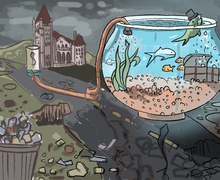Unusual offseason presents mental health issues for athletes, experts say
Illustration by Sarah Allam
Even before an unprecedented offseason, college athletes may have already been at higher risk to mental health issues.
The Daily Orange is a nonprofit newsroom that receives no funding from Syracuse University. Consider donating today to support our mission.
Like most college football fans on Aug. 11, Syracuse’s football players refreshed their Twitter feeds and sent texts in their group chats.
They were in the third month of voluntary offseason workouts and then training camp, all with strict COVID-19 measures in place, and their friends in the Pac-12 and Big Ten had just found out their seasons were postponed. Was the Atlantic Coast Conference next?
“We weren’t sure if we were going super hard for no reason if we weren’t going to have a season,” linebacker Mikel Jones said on Sept. 1.
That uncertainty is a quintessential aspect of sport psychology, Arizona State University kinesiology lecturer Kristin Hoffner said. Not knowing typically basic facts — if there will be a season, when it will start, who is on the schedule — can add stress and anxiety to athletes who are trained to control what they can.
And though the ACC decided to continue its fall football season, experts say the summer’s uncertainty, compounded with the COVID-19 pandemic and national protests against systemic racism and police brutality, caused mental health challenges for college athletes.
When asked about the impact of such a chaotic offseason, SU head coach Dino Babers said “one of the things we really need to be concerned about is the mental health issue that’s going on with the young people today.”
That problem is not unique to the SU football program. Nearly one in five American adults will have a diagnosable mental health condition in any given year, and 18-25 year olds make up the highest prevalence of serious mental illness. Research also suggests college athletes may be more vulnerable — a 2016 NCAA survey of nearly 21,000 athletes found about 30% reported feeling “intractably overwhelmed” a month prior to the survey.
“The biggest thing with professional athletes, with high-level collegiate athletes — and coaches, too — they can prepare, they can sit there and come up with a game plan and figure out what’s going on for a lot of complex situations. But when you have something that you can’t control, there’s an unknown, you can only do so much. That’s where the real challenge is,” said Sean Quinn, director of mental conditioning at the Moawad Group.
Quinn said there may be a stigma for football players, and it can be tough for someone to seek help. A support system within a team, including coaches and a leadership group, is key for players dealing with issues, he said.
At Syracuse, Babers has held several team meetings — he calls them “state of the unions” — where anyone’s allowed to share what’s on their minds. SU Athletics also has two part-time therapists on staff to provide counseling out of Manley Field House, a feature that follows the NCAA’s mental health best practice guidelines from 2016.
The mental health issue received more attention after multiple recent high-profile tragedies. The NCAA’s chief medical officer called mental health the No. 1 health concern of college sports in 2013, one year before Pennsylvania track runner Madison Holleran died by suicide and five years before Washington State quarterback Tyler Hilinski also died by suicide.
Although they’re on a “pedestal” as public figures, Hoffner said, athletes experience the same anxiety, stress and depression as anyone else. This summer’s uncertainty could’ve complicated emotions for football players, whose brains are wired to control what they can, mental health advocate and former SU men’s basketball player Trevor Cooney said.
“That’s how we’re trained, really,” Cooney said. “Our minds work like that, which is great, except for right now … You don’t really have people you can turn to who’ve been through this before to help us. So that makes it really tough.”
Cooney became a mental health advocate in 2018 after a friend’s suicide. As a three-year starter, Cooney knows exactly what kind of pressure Syracuse athletes are under. He deactivated his social media accounts during the season to focus on his game and ignore outside noise from fans and the media, he said.
But it's one of those times where there's a lot of pain. And where there's a lot of pain there's going to be a lot of growth as well once it's all over.Dino Babers, Syracuse football head coach
Social media can always be a factor in mental health, but especially this summer with several high-profile incidents of police officers killing Black people. Some SU players took to social media after the police shot Jacob Blake in Kenosha, Wisconsin.
And it was all happening during a pandemic that disproportionately affects communities of color. Hoffner called all the converging issues weighing on athletes “very real” and “heavy.” She added that Black athletes may be unsure if those around them really care about their emotions — the teammates and coaches in a college sports universe that uses them to generate billions for mostly white coaches administrators and officials.
“A lot of those things that they’re dealing with, you really wish they didn’t have to deal with at that age,” Babers said. “You’d hope the older generation would’ve taken care of some of those ills. But it’s one of those times where there’s a lot of pain, and where there’s a lot of pain there’s going to be a lot of growth as well once it’s all over.”
If you or someone you know needs help, the Substance Abuse and Mental Health Services Administration (SAMHSA) can be reached at 1-800-662-HELP (4357) or TTY: 1-800-487-4889. SAMHSA provides free and confidential information 24 hours a day in English and Spanish for individuals and family members experiencing mental and/or substance use disorders.
Published on September 16, 2020 at 12:42 am
Contact Danny: dremerma@syr.edu | @DannyEmerman






